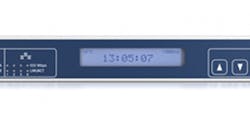Schweitzer Engineering Laboratories, Inc. has released the SEL-2488 Satellite-Synchronized Network Clock designed for critical infrastructure and harsh environments that require highly reliable, precise time synchronization.
The SEL-2488 Satellite-Synchronized Network Clock receives Global Navigation Satellite System (GNSS) time signals and distributes precise time via multiple output protocols,including IRIG-B and Network Time Protocol (NTP), and soon will add support for Precision Time Protocol (PTP) as a firmware upgrade. The SEL-2488 is accurate to industry-leading ±40 ns, which is ideal for applications requiring precise time information, such as synchrophasors. To further improve time distribution accuracy, the SEL-2488 provides time delay compensation for antenna cables and output cables on a per-port basis. If GNSS time signals become unavailable, the clock switches to the TCXO holdover, with 36 μs/day accuracy, or to an optional OCXO holdover, with 5 μs/day accuracy.
Leveraging the technology offered in the SEL-2730M 24-Port Ethernet Switch, SEL has included security features in the SEL-2488 that other critical infrastructure clocks don’t offer. These features include Syslog, the Ethernet standard for event messaging, which allows the SEL-2488 to integrate smoothly into a customer’s existing event system; role-based accounts and Lightweight Directory Access Protocol (LDAP) for user authentication; and a secure HTTPS web interface, which provides a graphical SkyView display for troubleshooting signal or antenna issues. The SEL-2488 also meets IEEE 1613 Class 1, an electric transient and interference standard for communications products.
The SEL-2488 offers additional security and reliability features, including Satellite Signal Verification in which the clock uses two satellite constellations to validate time signals, providing a layer of protection from GPS spoofing attacks. For fault tolerance, customers can opt for a second, redundant power supply, which can be connected to a second power input source. The clock operates within a range of –40° to +85°C (–40° to +185°F) and is backed by SEL’s ten-year, no-questions-asked warranty.
Designed, tested, and manufactured in Pullman, Washington, a standard SEL-2488 configuration, including a dual-constellation, high-gain GNSS antenna, retails for $2,700. PTP, as defined by IEEE 1588, will be available in a future release as a firmware upgrade. To learn more about the SEL-2488 Satellite-Synchronized Clock, visit www.selinc.com/p205.



